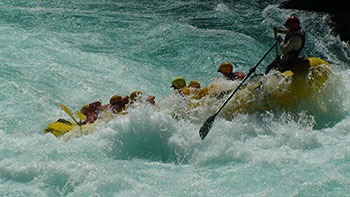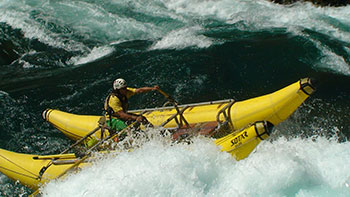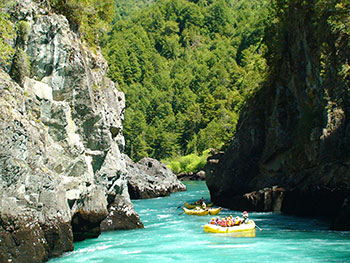Day 12 –
Infierno Canyon
February 11, 2008
Submitted by Pat
 We’re up early for coffee and to pack our gear for the move to our next camp. We pack our gear in dry bags and pile them where Don Ignacio and his oxen will pick them up and haul them to the bus. After breakfast we hike to the bus and drive to the put in. I’m pretty jazzed up. Today we’re going to run Infierno (Inferno) Canyon, a class 5.5+ rapid, plus Purgatorio (Purgatory – Class 5), Danza de los Angeles (Dance of the Angels – Class 4) and Escala de Jacobo (Jacob’s Ladder – Class 5). Nancy and I are scheduled to be in the front of the boat again since Aaron doesn’t want to change before Infierno Canyon. The river’s water level is very low, which makes some of these rapids much more technically challenging than they would be during higher water. More rocks, sucking holes and hydraulics to contend with during low water. And every rapid is different depending on the water level. There is no room for complacency.
We’re up early for coffee and to pack our gear for the move to our next camp. We pack our gear in dry bags and pile them where Don Ignacio and his oxen will pick them up and haul them to the bus. After breakfast we hike to the bus and drive to the put in. I’m pretty jazzed up. Today we’re going to run Infierno (Inferno) Canyon, a class 5.5+ rapid, plus Purgatorio (Purgatory – Class 5), Danza de los Angeles (Dance of the Angels – Class 4) and Escala de Jacobo (Jacob’s Ladder – Class 5). Nancy and I are scheduled to be in the front of the boat again since Aaron doesn’t want to change before Infierno Canyon. The river’s water level is very low, which makes some of these rapids much more technically challenging than they would be during higher water. More rocks, sucking holes and hydraulics to contend with during low water. And every rapid is different depending on the water level. There is no room for complacency.
Today we are joined by Rayno, a South African who is a guide in Sweden during the summer months and works in Chile for Earth River, videotaping the Futaleufu trips during the winter. He runs the rapids in a kayak, one of those small quick boats that can run anything. He will blast down the rapid and find a great vantage point so he can film the Cats and the raft as we come down.

When Aaron, our raft guide, pulls the raft over into an eddy prior to running the first Class 5+ rapid, he crosses his oars in front of his chest and leans forward and says something like, “Okay, so on this rapid, the goal is to stay in the boat. There’s a nasty hydraulic suck hole half way through on the right – if you fall into that, hold your breath, relax, and wait until you pop up. Then swim to the right where the Cats (catamarans) will be.” His words put my brain on overload – Okay, I don’t want to fall into the hole and if I do, gotta relax and when I come up, I have to swim to the right, or is it to the left? Then he describes the rapid – big rocks, deep holes, hydraulics – and outlines the strokes he will be calling out – “Hard forward”, then a “right turn”, maybe a “Get Down” or an “Over left”, depending on our line, followed by a quick “Back” and hopefully we will miss the huge rock that can flip us.
Lots of hoping. Lots of let’s try and stay in the boat. Okay, so let’s get going. I’m in the front paddling on the right and Nancy is in the front paddling on the left. Behind her are Kate and Frank. Behind me are Don, Laura and Barry. In front of us taking the lead, as always, is Peter in one catamaran and Chula in the other. As part of Earth River’s interest in our safety, they designed these “Cats” to be incredibly maneuverable and buoyant. You really have to work at it to tip one over. Their role is to scout routes down each of the rapids, make the Cats available for rescue if any of us falls out of the raft, carry gear, and to have a ball. On this day, both Cats are loaded with our dry bags.
 We have to portage the raft through one rapid, a man-made creation that is the result of blasting that had been done to widen a road. The blasts dropped tons of rocks and dirt into the river, creating a hidden menace of a rapid that isn’t safe to run in a raft. The Cats run it with our gear, but even Peter and Chula don’t hot dog on this one. We have to scramble on rocks – big, slippery boulders – to get around the rapid and back into the raft.
We have to portage the raft through one rapid, a man-made creation that is the result of blasting that had been done to widen a road. The blasts dropped tons of rocks and dirt into the river, creating a hidden menace of a rapid that isn’t safe to run in a raft. The Cats run it with our gear, but even Peter and Chula don’t hot dog on this one. We have to scramble on rocks – big, slippery boulders – to get around the rapid and back into the raft.
As we prepare to enter the next rapid, Aaron maneuvers the raft into the line he wants and then calls for the first stroke. I feel my heart pounding against my life jacket that is on so tight I can hardly breathe. It’s really important to have them on tight, because if I do fall in, the way out is to have a teammate grab me by the life jacket at the shoulders and pull. If it’s loose, the life jacket will come off and I’ll be left behind. Not a good idea. So all our jackets are tight. And I feel my heart pounding as we turn into the rapid.
When Aaron calls the first stroke, a single “Forward” and then an immediate “Stop” to get us on the exact line he wants, Nancy and I enter a quiet, focused place. First we look at each other, briefly, to start the rhythm of our stroke so we’re paddling in tandem. We share a feral smile, and then we look ahead and concentrate on following Aaron’s shouted instructions over the sounds and violent thrashing of the raft. Sometimes we’re positioned to go over a five or six foot drop off – those make my heart leap – and we always drop into it, water crashing over us, the waves doing their best to pull us out of the boat. When that happens, the best answer is to put weight over my legs and lean into the boat slightly and always, always keep paddling when we’re told. Even if I paddle air – paddle air and keep the rhythm. One of the best experiences Nancy and I have as front paddlers was on a rapid Aaron calls a wave train. This is a rapid that isn’t very technical, not a lot of right or left movement, just straight up the gut and into each wave – bam, bam, bam, bam. Nancy and I dig our paddles deep into the wave and stroke and as we prepare to dig into the water again we time it so we’re digging right into the next wave, wave after wave of perfect mirrored paddling, hard and tight. It is incredible!

On this day, we only have one close call, when Aaron calls an “over left” and our combined weight on the left side of the raft is enough to pull us off the rock that wants to flip us and lets us continue down the river unharmed. Whoops and whoo hoos can be heard and we all perform a paddle high five. Yeah!
We arrive at the Cave Camp put in just above the Zeta Rapid (Class 6), which is basically unrunnable. Peter’s Cat and the raft are lined through the rapid (shaped like a Z, hence the name Zeta, Spanish for Z) although Chula in the second Cat ran the thing. Amazing. Aaron leads us to a transition area where we change out of our wet suits and paddle jackets and he takes us on a tour of Cave Camp (Casa Campo de Piedra). An amazing series of paths through bamboo jungle to the kitchen, the massage tent, showers, toilets, cliff dwellings, hot tub, dining area for good weather with a view of the river and a dining area located under a huge boulder that creates a natural cave for bad weather.
But first he takes us out to Lost Beach – a beautiful, pristine, calm eddy of water that is part of the Fu but protected by rock. The color of the water is indescribable and we all walk around and ooh and aah. The afternoon is hot and the water looks so inviting that Aaron suggests Nancy and I dive in to cool off. We think sure, why not – it looks great, so we stand on a rock and dive in side by side. OH MY GOD – the water is frigid, much colder than the actual river water (which is in the low 60s), and we scream bloody murder when we come up for air. We both get out immediately while everyone laughs, especially Aaron. He can’t believe we’re so trusting and gullible that we would dive in without even touching a toe to the water. Oh, well – it’s one of the best parts of the trip video so I wouldn’t change it.
After our dip we finish the tour and he assigns us our new homes. Mine overlooks the Zeta rapid and the constant sound of water is mesmerizing. The only negative is the mosquitoes. Too much standing water, I guess. At least the horse flies have been left behind. After settling in I make a reservation for a half hour massage to get the kinks worked out of my shoulders from all the paddling. It feels great and so does a shower. A half an hour in the hot tub with appetizers served tub side is followed by dinner served on a huge rock outcropping that gives us a view of the canyon and Zeta rapid. Sublime. The night is perfect for sleeping and for once I don’t get too hot or too cold. I used the mosquito netting provided since I actually had enough energy to read for the first time since I started on this adventure. Tomorrow is going to offer new and challenging physical opportunities as we have a non-rafting day – crossing the river via a Tyrolean traverse, a 3-hour hike with 1,200 feet of elevation gain, and a new camp – Tree House Camp. Whoo Hooo!
